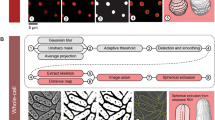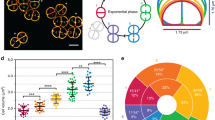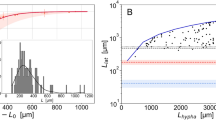Abstract
The cellular slime mould Polysphondylium pallidum has a fruiting body with whorls of branches spaced at regular intervals along the stalk (Fig. 1). The spacing between successive whorls is quite regular and under genetic control1. Because stalk cell number per interval correlates strongly with interval length, we have studied the influence of ploidy on the distance between whorls to determine if cell counting could account for the spacing. It is known that diploid spores and amoebae of Dictyostelium discoideum and Polysphondylium violaceum are roughly twice the size of their haploid parents2,3, and we find that stalk cells in P. pallidum follow the same pattern. Our results show that the number of stalk cells between successive whorls in haploids is approximately twice the number in diploids, while the spacing remains the same. This clearly indicates that spacing is not achieved by a cell counting mechanism. Instead, it appears to depend on distance.
This is a preview of subscription content, access via your institution
Access options
Subscribe to this journal
Receive 51 print issues and online access
$199.00 per year
only $3.90 per issue
Buy this article
- Purchase on Springer Link
- Instant access to full article PDF
Prices may be subject to local taxes which are calculated during checkout
Similar content being viewed by others
References
Spiegel, F. W. & Cox, E. C. (in preparation).
Sussman, M. & Sussman, R. R. J. gen. Microbiol. 28, 417–429 (1962).
Warren, A.J., Warren, W.D. & Cox, E. C. Genetics 83, 25–47 (1976).
Fankhauser, G. in Analysis of Development (eds Willier, B.H. Weiss, A. & Hamburger, V.) 126–150 (Saunders, Philadelphia, 1955).
Darlington, C. D. Chromosome Botany and the Origins of Cultivated Plants, 3rd edn (Allen and Unwin, London, 1973).
Stebbins, G. L. Chromosomal Evolution in Higher Plants (Addison-Wesley, Reading, Massachusetts, 1971).
Held, L. I. Jr, Wilhelm Roux Arch. EntwMech. Org. 187, 105–127 (1979).
Bonner, J. T. The Cellular Slime Molds (Princeton University Press, 1967).
Harper, R. A. Bull. Torrey Bot. Club 59, 49–84 (1932).
Wilcox, M. Nature 228, 686–687 (1970).
Francis, D. W. Differentiation 15, 187–193 (1970).
Raper, K. B. in The Fungi (eds Ainsworth, G. C., Sparrow, F.K. & Sussman, A.S.) 9–36 (Academic, New York, 1973).
Author information
Authors and Affiliations
Rights and permissions
About this article
Cite this article
Spiegel, F., Cox, E. A one-dimensional pattern in the cellular slime mould Polysphondylium pallidum. Nature 286, 806–807 (1980). https://doi.org/10.1038/286806a0
Received:
Accepted:
Published:
Issue Date:
DOI: https://doi.org/10.1038/286806a0
This article is cited by
-
The determination of spatial pattern inDictyostelium discoideum
Journal of Biosciences (1992)
-
The scale-invariance of spatial patterning in a developing system
Wilhelm Roux's Archives of Developmental Biology (1981)
Comments
By submitting a comment you agree to abide by our Terms and Community Guidelines. If you find something abusive or that does not comply with our terms or guidelines please flag it as inappropriate.



